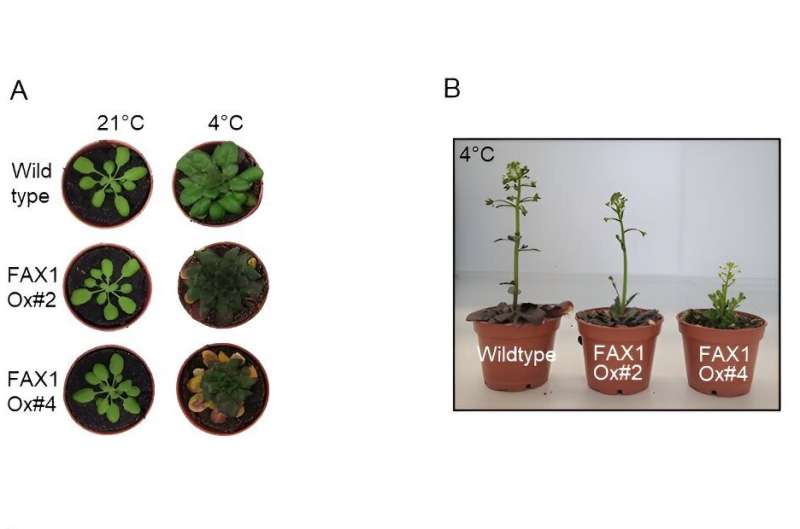This article has been reviewed according to Science X's editorial process and policies. Editors have highlighted the following attributes while ensuring the content's credibility:
fact-checked
proofread
Study shows how plants adapt to cold ambient temperatures and frost

As plants are sessile organisms, they must be highly flexible in their ability to adapt to a wide range of environmental conditions in order to survive. Researchers from the Department of Plant Physiology at the RPTU Kaiserslautern are investigating plant adaptation mechanisms, particularly to abiotic stress factors such as light intensity or temperature.
They have now reached a new milestone. Ph.D. student Annalisa John has used the model plant thale cress (Arabidopsis thaliana) in her research work to decode which cellular mechanisms plants use to adapt to cold temperatures and frost. The results of the study have been published in The Plant Cell.
In general, plants change their metabolic processes as a typical reaction to the onset of cold temperatures. This primarily affects the structures of biomembranes that enclose cells and the cell organelles within them, acting as a thin boundary layer.
"When exposed to cold, the composition of the lipid bilayers that make up the cell membranes must be modified quickly and efficiently," explains John, who is working on her Ph.D. in plant physiology and is the first author of the study. These adaptations are necessary to keep membranes fluid or mobile even at low environmental temperatures, which is an essential prerequisite for their functionality.
To adapt and remodel the composition of cell membranes, plants initiate the production of newly generated lipids. The synthesis takes place in two cell compartments, the chloroplasts and the endoplasmic reticulum (ER). To do this, fatty acids—which represent the basic building blocks of lipid synthesis—must first be synthesized within the green chloroplasts, so that the fatty acids can then be transported out of the chloroplast via the transport protein Fatty Acid Export 1 (FAX1) in order to subsequently enter the ER.
"Prior to these investigations, our research group had already observed that, in addition to other proteins, the abundance of FAX1 decreases significantly when Arabidopsis plants are exposed to cold temperatures," says John. "However, we didn't know whether this decrease was relevant for cold and frost adaptation and how the targeted decrease in the FAX1 protein abundance is controlled."
The chloroplasts provide the answer
John found that plant mutants that continuously produce the FAX1 protein in large quantities (so-called FAX1 overexpressors) and are exposed to cold temperatures showed the following behavior: They grew inefficiently and tended to age prematurely, showed defects in photosynthesis and produced large amounts of toxic substances—reactive oxygen species such as hydrogen superoxide.
In addition, the balanced lipid synthesis in the chloroplasts and in the ER was disturbed by the permanent fatty acid export via FAX1, which differs significantly from the situation in wild-type plants. While wild types particularly activate lipid synthesis in the chloroplasts during cold, the FAX1 overexpressors synthesize quite a lot of lipids in the ER.
"We have also identified a protease responsible for degrading FAX1 exclusively during cold temperatures, known as the rhomboid-like protease 11 (RBL11 protease)," explains John. "Like FAX1, RBL11 is located in the inner envelope of the chloroplasts. Plant mutants lacking the RBL11 protease showed the same symptoms as the FAX1 overexpressors. We now know that the degradation of FAX1 in the cold is highly important for adaptation to low environmental temperatures and we also know how the degradation occurs."
"The aim of this coordinated research program is to understand the diverse functions of chloroplasts in the adaptation of plants to changing environmental conditions. The findings from Ms. John's Ph.D. thesis will make an important contribution to the research program. It may therefore be possible to specifically optimize the cold tolerance of sensitive crop plants so that they can survive spontaneous phases of low temperatures or even frost," says Professor Dr. Ekkehard Neuhaus, who is responsible for the Department of Plant Physiology.
More information: Annalisa John et al, Degradation of FATTY ACID EXPORT PROTEIN1 by RHOMBOID-LIKE PROTEASE11 contributes to cold tolerance in Arabidopsis, The Plant Cell (2024). DOI: 10.1093/plcell/koae011
Provided by Rheinland-Pfälzische Technische Universität Kaiserslautern-Landau




















